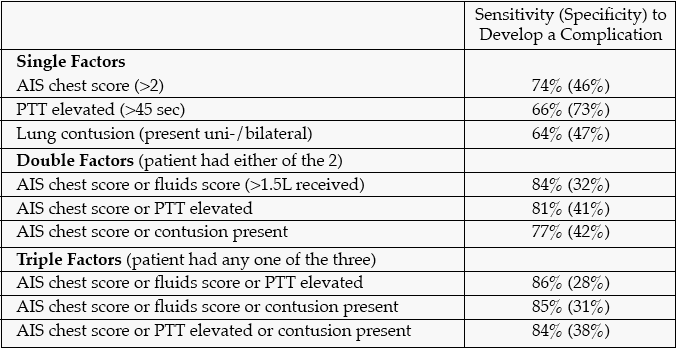
Thurs., 10/16/08 Tibia/Polytrauma, Paper #11, 4:14 pm OTA-2008
Clearing Polytrauma Patients for Major Surgery: Which Parameters Are The Best?
Hans-Christoph Pape, MD1 (a-AO Foundation, Grant by H & S Re Insurance Company);
Michael McClinsy1 (a-AO Foundation); Ivan S. Tarkin, MD1 (a-AO Foundation);
Christian Krettek, MD2 (a-AO Foundation); Peter V. Giannoudis, MD3 (a-AO Foundation);
EPOFF Study Group (a-AO Foundation);
1University of Pittsburgh Medical Center, Pittsburgh, Pennsylvania, USA;
2Hannover Medical School, Hannover, Germany;
3Academic Orthopaedic Unit, Leeds General Infirmary, Leeds, United Kingdom
Purpose: In polytrauma, the aim of fracture management is to perform initial definitive stabilization whenever the patient is in adequate condition. Several clinical parameters have been described to assess the patient’s clinical condition. We tested which parameters/combination of parameters best describe the patient condition.
Methods: In this prospective cohort study, our inclusion criteria were: New Injury Severity Score (NISS) >16 points, or 3 fractures and Abbreviated Injury Scale (AIS) ≥2 points and another injury (AIS ≥2 points), and age 18 to 65 years. We excluded patients in unstable or critical condition. Parameters tested for grading of whether or not a patient is cleared included systolic blood pressure, volume replacement, number of blood units/ 6 hours, AIS of all body regions, thoracic trauma score, uni-/bilateral lung contusion, platelet count, and prothrombin time (PTT). Endpoints consisted of clinical complications (pneumonia, sepsis, acute respiratory distress syndrome, acute lung injury, multiple organ failure).
Results: Parameters were tested for normal distribution. A sensitivity and specificity analysis was performed for all variables individually. In addition, variable combinations (double and triple factors) were tested to see if they led to an increase in sensitivity. Specificity values are in parentheses below:

The systolic blood pressure and the numbers of blood units administered were not sensitive in predicting complications.
Conclusion: The most sensitive individual parameters were the AIS chest score, elevated PTT levels, fluid requirements, and the presence of a lung contusion at time of admission. By using a combination of three factors, the predictive value for developing complications was improved.
Significance: A combination of conventional scores and physiologic parameters is useful to judge the clinical condition and clear a patient for surgery.
If noted, the author indicates something of value received. The codes are identified as a-research or institutional support; b-miscellaneous funding; c-royalties; d-stock options; e-consultant or employee; n-no conflicts disclosed, and *disclosure not available at time of printing.
• The FDA has not cleared this drug and/or medical device for the use described in this presentation (i.e., the drug or medical device is being discussed for an “off label” use). ◆FDA information not available at time of printing. Δ OTA Grant.